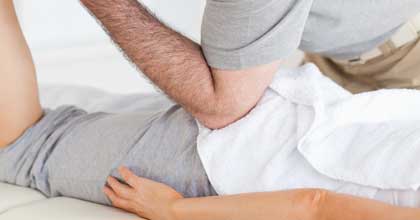
Hip Pelvic Pain
Hip, groin or pelvic pain can be very frustrating and historically difficult to diagnose. It can due to a combination of local hip joint structures, pelvic joints, surrounding muscles or nerves. Sometimes pain can be referred from the lower back into the hip or groin.
Establishing which structure is at fault can be tricky but with a thorough assessment the answer quickly becomes clear. Clients often complain of pain on walking, rolling in bed, using stairs, crossing legs or playing sports. Numbness and tingling are uncommon but often nothing serious when present.
There are many conditions which can give a combination of pain in different areas which include but are not limited to:
• Osteoarthritis (OA). This generally tends to affect older members of the community. Difficulty lifting or rotating the leg are common and walking is usually accompanied with pain or discomfort. An excel ent resource for information on OA can be found here
• Femoro acetabular impingement (FAI) describes a problem between the ball and socket joint of the hip. There are 2 main types; Cam and Pincer lesions, which can improve with treatment and rehabilitation but sometimes require surgery in extreme cases. Labral tears are often a problem associated with FAI and can be a source of hip and groin pain.
• Groin/adductor muscle strain. The adductor muscles are those on the inner part of the thigh. When they contract they pull your leg across your body. One of their main other roles is to support your body weight when you are stood on one leg. They are often injured with strains during sports (particularly kicking) and can be treated and rehabilitated to get you pain free.
• Osteoarthritis (OA). This generally tends to affect older members of the community. Difficulty lifting or rotating the leg are common and walking is usually accompanied with pain or discomfort. An excel ent resource for information on OA can be found here
• Femoro acetabular impingement (FAI) describes a problem between the ball and socket joint of the hip. There are 2 main types; Cam and Pincer lesions, which can improve with treatment and rehabilitation but sometimes require surgery in extreme cases. Labral tears are often a problem associated with FAI and can be a source of hip and groin pain.
• Groin/adductor muscle strain. The adductor muscles are those on the inner part of the thigh. When they contract they pull your leg across your body. One of their main other roles is to support your body weight when you are stood on one leg. They are often injured with strains during sports (particularly kicking) and can be treated and rehabilitated to get you pain free.
• Lateral Hip pain. This is traditionally called trochanteric bursitis although now is also called the rather wordy ‘Greater Trochanteric Pain Syndrome’ (or GTPS for short). Pain is normally over and around the bony part (trochanter) on the outer part of the top of your thigh or hip area. Generally it is painful to lie on and walking is painful. The pain can sometimes be due to one of the bursas (a fluid filled sac between the tendon and bone) being irritated, although current evidence shows that generally the problem has multiple contributing factors, particularly tendons and muscles being painful.
• Pelvic Girdle Pain (PGP) or Symphesis Pubis Dysfunction (SPD) describes pain in and around the pelvis including the sacroiliac joints (where the pelvis meets the base of the spine). Women often suffer from pain in this area during or after pregnancy but anyone can get pain arising from this area, sometimes from a simple trip or fall.
• A Sportsman’s hernia or ‘sporting groin’ is often related to weakness or immaturity in the abdominal wall where sometimes abdominal tissue can poke through. There are commonly other factors involved such as weakness in the trunk or other hip and leg muscles which can be rehabilitated effectively without surgery.
• Pelvic Girdle Pain (PGP) or Symphesis Pubis Dysfunction (SPD) describes pain in and around the pelvis including the sacroiliac joints (where the pelvis meets the base of the spine). Women often suffer from pain in this area during or after pregnancy but anyone can get pain arising from this area, sometimes from a simple trip or fall.
• A Sportsman’s hernia or ‘sporting groin’ is often related to weakness or immaturity in the abdominal wall where sometimes abdominal tissue can poke through. There are commonly other factors involved such as weakness in the trunk or other hip and leg muscles which can be rehabilitated effectively without surgery.
